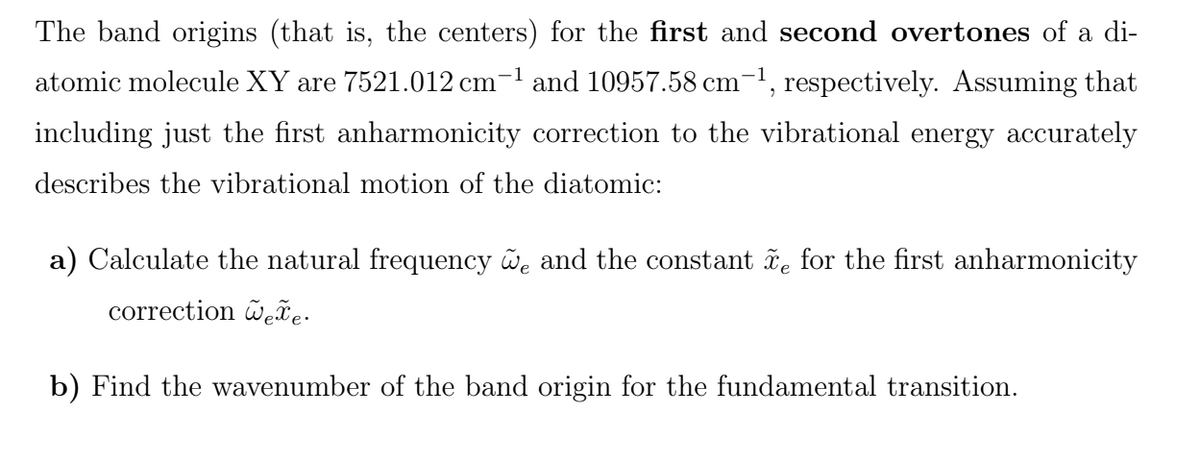The band origins (that is, the centers) for the first and second overtones of a di- atomic molecule XY are 7521.012 cm-1 and 10957.58 cm-1, respectively. Assuming that including just the first anharmonicity correction to the vibrational energy accurately describes the vibrational motion of the diatomic: a) Calculate the natural frequency we and the constant ãe for the first anharmonicity correction eãe. b) Find the wavenumber of the band origin for the fundamental transition.
The band origins (that is, the centers) for the first and second overtones of a di- atomic molecule XY are 7521.012 cm-1 and 10957.58 cm-1, respectively. Assuming that including just the first anharmonicity correction to the vibrational energy accurately describes the vibrational motion of the diatomic: a) Calculate the natural frequency we and the constant ãe for the first anharmonicity correction eãe. b) Find the wavenumber of the band origin for the fundamental transition.
Principles of Modern Chemistry
8th Edition
ISBN:9781305079113
Author:David W. Oxtoby, H. Pat Gillis, Laurie J. Butler
Publisher:David W. Oxtoby, H. Pat Gillis, Laurie J. Butler
Chapter20: Molecular Spectroscopy And Photochemistry
Section: Chapter Questions
Problem 57AP
Related questions
Question

Transcribed Image Text:The band origins (that is, the centers) for the first and second overtones of a di-
atomic molecule XY are 7521.012 cm-1 and 10957.58 cm-1, respectively. Assuming that
including just the first anharmonicity correction to the vibrational energy accurately
describes the vibrational motion of the diatomic:
a) Calculate the natural frequency we and the constant ñe for the first anharmonicity
correction õeãe-
b) Find the wavenumber of the band origin for the fundamental transition.
Expert Solution
This question has been solved!
Explore an expertly crafted, step-by-step solution for a thorough understanding of key concepts.
This is a popular solution!
Trending now
This is a popular solution!
Step by step
Solved in 3 steps with 2 images

Knowledge Booster
Learn more about
Need a deep-dive on the concept behind this application? Look no further. Learn more about this topic, chemistry and related others by exploring similar questions and additional content below.Recommended textbooks for you

Principles of Modern Chemistry
Chemistry
ISBN:
9781305079113
Author:
David W. Oxtoby, H. Pat Gillis, Laurie J. Butler
Publisher:
Cengage Learning

Physical Chemistry
Chemistry
ISBN:
9781133958437
Author:
Ball, David W. (david Warren), BAER, Tomas
Publisher:
Wadsworth Cengage Learning,


Principles of Modern Chemistry
Chemistry
ISBN:
9781305079113
Author:
David W. Oxtoby, H. Pat Gillis, Laurie J. Butler
Publisher:
Cengage Learning

Physical Chemistry
Chemistry
ISBN:
9781133958437
Author:
Ball, David W. (david Warren), BAER, Tomas
Publisher:
Wadsworth Cengage Learning,
